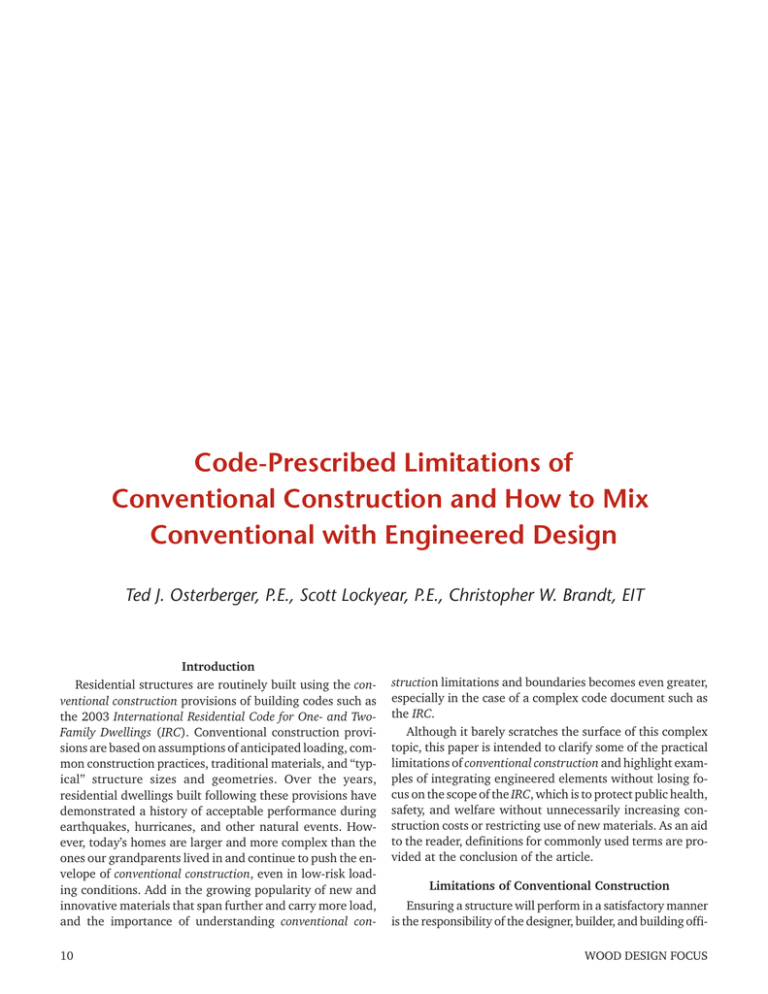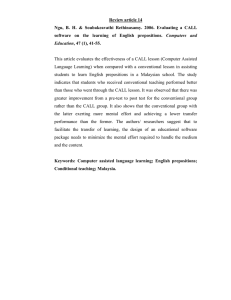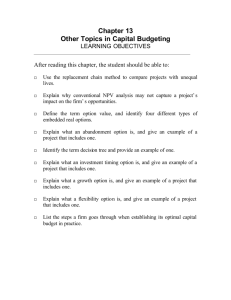selves with the tables, specifications, illustrations, and gen- References eral design concepts. WFCM
advertisement

selves with the tables, specifications, illustrations, and general design concepts. For those who cannot attend the WFCM workshop, AF&PA offers a web-based course and electronic workbook through its website at www.awc.org. Conclusion Over the past two decades, new prescriptive design methods for wood-frame construction have been developed based on engineering mechanics and adopted by the model codes. Engineered prescriptive solutions are often used in high natural-hazard regions where the limits of conventional construction in the building codes may be exceeded. AF&PA’s WFCM provides both engineered and prescriptive solutions for wood-frame structures subject to high wind, seismic, and snow loads. For more information on the WFCM, AWC’s wood building design course or other educational materials, visit AWC’s website at www.awc.org. References Douglas, B.K. and H. Sugiyama. 1994. Perforated Shear Wall Design Approach. Presented at the 1994 American Society of Agricultural Engineers International Winter Meeting. Paper No. 944548. American Society of Agricultural Engineers, St. Joseph, MI. Polensek, Anton. 1976. Rational Design Procedure for Wood-Stud Walls Under Bending and Compression Loads. Wood Science. Vol. 9, No. 1. Sugiyama, Hideo. 1981. The Evaluation of Shear Strength of Plywood-Sheathed Walls with Openings. Mokuzai Kogyu (Wood Industry). Vol. 36, No. 7. Scott Lockyear, P.E., Structural Engineer, American Wood Council, American Forest & Paper Association, Washington, DC. Code-Prescribed Limitations of Conventional Construction and How to Mix Conventional with Engineered Design Ted J. Osterberger, P.E., Scott Lockyear, P.E., Christopher W. Brandt, EIT Introduction Residential structures are routinely built using the conventional construction provisions of building codes such as the 2003 International Residential Code for One- and TwoFamily Dwellings (IRC). Conventional construction provisions are based on assumptions of anticipated loading, common construction practices, traditional materials, and “typical” structure sizes and geometries. Over the years, residential dwellings built following these provisions have demonstrated a history of acceptable performance during earthquakes, hurricanes, and other natural events. However, today’s homes are larger and more complex than the ones our grandparents lived in and continue to push the envelope of conventional construction, even in low-risk loading conditions. Add in the growing popularity of new and innovative materials that span further and carry more load, and the importance of understanding conventional con10 struction limitations and boundaries becomes even greater, especially in the case of a complex code document such as the IRC. Although it barely scratches the surface of this complex topic, this paper is intended to clarify some of the practical limitations of conventional construction and highlight examples of integrating engineered elements without losing focus on the scope of the IRC, which is to protect public health, safety, and welfare without unnecessarily increasing construction costs or restricting use of new materials. As an aid to the reader, definitions for commonly used terms are provided at the conclusion of the article. Limitations of Conventional Construction Ensuring a structure will perform in a satisfactory manner is the responsibility of the designer, builder, and building offiWOOD DESIGN FOCUS cial. Since conventional construction is largely based on decades of traditional practices and historical performance, it is often difficult to determine when conventional construction techniques are not adequate and engineered design should be used. One approach is to examine the limits embedded in IRC tables and provisions. For example, since solid-sawn joists are typically not available in lengths greater than 26 feet, the IRC tables do not show spans exceeding that length. Although conventional construction does not explicitly restrict spans to 26 feet or less, the designer is required to perform additional analysis, including consideration of load path, when provisions in the IRC are exceeded. This same logic can be applied to most of the code tables and provisions. For convenience, several limits to the prescribed information in the IRC are provided in Figure 1. One of the key elements in determining boundaries of conventional construction is the evaluation of the overall building dimensions, including member spans and building height. Overall size of the structure between points of vertical support has historically been limited by allowable spans for floor joist and rafters. In the case of a ridge board system used in roof construction, rafter tie connection requirements in Table R802.5.1(9) of the IRC are not tabulated for roof spans greater than 36 feet. Once again, conventional construction does not explicitly limit the distance between points of vertical support, although this embedded limit does control the resulting horizontal thrust on the connection. Overall building height is typically limited by local zoning ordinances, with the number of allowed stories limited to 3 or less per IRC Section R101.2. For basements and crawl spaces that are partially above grade, detailed provisions are given in IRC Section R202 to determine if the basement should be considered an additional story. While provisions for basements are fairly clear, requirements for determining if an attic space is an additional story are not. Although not explicitly stated, it is reasonable to assume that if the majority of the attic space is classified as a habitable space, then it would be considered an additional story. Sections R304 and R305 provide requirements for minimum room areas and ceiling heights for habitable space. While limitations for most prescriptive components in typical residential construction are adequate, there are some notable areas where additional provisions would be beneficial. Currently, some solutions in pre-engineered code tables specify headers and beams that lead to large reactions (4,000 to 8,000 lb.). These loads are beyond the underlying assumptions for other conventionally specified members within the load path, many of which are based on uniform loading only. It would benefit the design community if the code were to identify these conditions and provide provisions for ensuring a complete load path to the foundation. Another area where additional provisions would be beneficial is hip and valley rafter systems. Current provisions in Section R802.3 are based on historical performance since Figure 1.—Structural limits. Fall 2003 11 there is not a widely accepted method for engineering hip and valley rafter systems. While historical performance would indicate that hip and valley rafter systems perform adequately for most applications within the limits of conventional construction, when large spans or loads are present, the hip or valley rafter assembly may cause exterior walls to deflect or may overload thrust connections. In these cases, additional consideration is required to ensure that the structure performs as intended. Regardless of whether conventional construction provisions are explicitly used or engineering analysis is used, the structure must be able to provide a complete load path capable of transferring forces from their point of origin through the load-resisting elements to the foundation (IRC Section R301.1). In general, design solutions and framing practices in the IRC will ensure that components have adequate capacity to transfer loads into the foundation. However, an understanding of limits to conventional construction is critical since these design solutions are only valid when the underlying assumptions for loads and geometry are not exceeded. When a structure, or any portion thereof, is beyond the applicability limits of conventional construction (load, span, etc.), additional analysis is needed to ensure that performance expectations for conventional construction are met. This typically includes design of both the members and supporting load path, unless forces transferred to supporting members can be rationalized as being within the limitations of conventional construction. dance with accepted engineering practice. For example, SCL headers are frequently used because their sizes are compatible with solid-sawn construction and can be easily substituted into an otherwise conventionally constructed building. In this case, use of an alternate product would not require engineering analysis beyond design of the header since the application is within the bounds of conventional construction. However, a traditional static analysis is not specifically required by the code for alternate products. Another option is available since IRC Section R104.11 only requires that the substituted product demonstrate equivalence with code-prescribed solutions. This method may be preferred in cases where code provisions are conventionally specified making it difficult to provide an equivalent engineering analysis. For instance, stud walls in the IRC are conventionally specified since commonly used design methods do not account for the additional capacity that is provided by composite action and redundancy in the wall assembly. While actual capacity of an individual stud may be difficult to estimate, it is known that the stud should be able to resist bending, compression, and tensile forces, and also should provide adequate connection properties for attachment of sheathing, gypsum, etc. If an alternate component can be shown to have an equivalent or better ability to resist loads and accommodate fasteners relative to a conventionally specified component, the alternate component is permitted. Mixing Conventional and Engineered Product Design Conventional construction has a long history of satisfactory performance. As size and complexity of buildings increase, and alternate products gain popularity, knowledge of the underlying assumptions of conventional construction becomes critical. In cases where the limits of conventional construction are exceeded, whether explicitly stated or implied through tabulated limits, an engineering analysis should be conducted to ensure adequate structural performance and that a complete load path for that component is maintained. This applies regardless of whether it is a traditional material such as sawn lumber or a proprietary product. When alternate components are used as a substitute for conventionally specified components, it is not always necessary to conduct a complete engineering analysis provided equivalency has been established on a rational basis. Engineered wood products, such as prefabricated wood I-joists, structural composite lumber (SCL), or metal plate connected wood trusses, are becoming increasingly popular in residential structures. The uniformity, ability to span longer distances, and ability to have components pre-fabricated are appealing to many builders. The IRC permits use of such products in Section R301.1.3. Examples of correctly integrating alternate products into conventional construction are provided below. Member Exceeds Limitations of Conventional Construction — When an alternate product is used in an application that exceeds the limits of the IRC (load, span, etc.) in a building of other than conventional construction, the member and supporting load path should be designed. For example, an open floor plan may necessitate use of end-jointed lumber spanning longer than 26 feet, or heavy snow loads and long spans may require metal plate connected wood trusses. Both of these components and members supporting them would require additional analysis since conventionally specified requirements are not provided in the IRC. Alternate Products in Conventional Applications — When a building meeting conventional construction limitations contains products not described in the code, two approaches are available. The first option is to design the member in accor12 Conclusions Definitions Conventional construction. A level of design generally based on traditional construction methods and materials that have a history of good performance for specific building types and sizes. Both conventionally specified and pre-calculated members and connections are prescriptively specified in codes and may be combined to form a structure or structural assembly. Conventionally specified members or connections. Members or connections prescriptively specified by the codes, but not WOOD DESIGN FOCUS associated with explicit engineering calculations related to structural performance requirements. Examples: Wall stud specifications in IRC Table 602.3(5) and many of the minimum connection specifications in IRC Table R602.3(1). Engineered members or connections. Members or connections engineered for application-specific solutions based on known span and loading conditions. For members or connections that are conventionally specified or that have application conditions outside the scope of pre-calculated tables, engineered solutions are required. Engineered solutions are permitted to replace members or connections used in conventional construction. Examples: Sawn lumber members supporting concentrated loads, structural composite lumber headers, prefabricated wood I-joists, and metal plate connected wood trusses. Pre-calculated (Pre-engineered) members or connections. Members or connections prescriptively-specified by the codes based on engineering calculations for a specific set of underlying assumptions. Examples: Floor joist span tables, such as IRC Table R502.3.1(1). References American Forest & Paper Association. 2001. Wood Frame Construction Manual for One- and Two-Family Dwellings. Washington, DC. International Code Council, Inc. 2003. International Residential Code for One- and Two-Family Dwellings. Falls Church, VA. International Code Council, Inc. 2003. International Building Code. Falls Church, VA. Ted J. Osterberger, P.E., Applications Engineering Manager, Trus Joist, A Weyerhaeuser Business; Scott Lockyear, P.E., Structural Engineer, American Forest & Paper Association; Christopher W. Brandt, EIT, Staff Engineer, Trus Joist, A Weyerhaeuser Business. Common Engineering Issues in Conventional Construction Jay H. Crandell, P.E. and Vladimir Kochkin Introduction Conventional wood-frame construction, unlike many other technologies, does not find its beginning in a laboratory or through some well-orchestrated technology development program. Conventional construction is simply a unique American tradition born from necessity and old-fashioned ingenuity. But, the engineering challenge with conventional construction is to determine just what it is and how it behaves as a structural system under a variety of material choices and building applications that are possible today. To understand conventional construction, both its strengths and its weaknesses, it must be “reverse engineered” and then re-engineered – a process that has been going on for a long time as new research is conducted, engineering tools are sharpened, new materials are integrated into practice, and house styles evolve. It is true that conventional construction is not what it is used to be, yet many engineering issues with conventional construction are the same today as they were many years ago. However, as more conventional buildings require an engineered design, these Fall 2003 issues have become challenges that take on a much greater level of importance. History of Conventional Construction A fairly complete history on conventional construction is found in Review of Structural Materials and Methods for Home Building in the United States: 1900 to 2000 (HUDa 2001). Only key points relevant to background for this article are repeated here. In the mid-1800s, as milled lumber became more readily available, balloon framing appeared on the American frontier. Different from earlier timber-frame construction of European descent, balloon framing initiated the use of small, repetitive wood structural members (e.g., studs). By 1900, balloon framing was the dominant method of wood-frame house construction – a position which would continue until post-World War II. In the 1940s and 1950s, a new form of light-frame wood construction, known as platform framing, became popular (Fig. 1) for various practical reasons. 13





